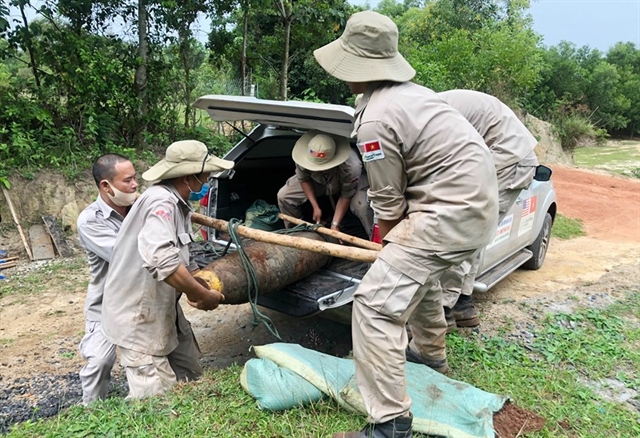Life blooms again on unexploded ordnance hotspot in central Việt Nam
Society – Economy - Ngày đăng : 09:55, 12/08/2024
 |
| A PTVN's team disposes of a large bomb weighing approximately 227kg, discovered at a quarry in Tân Hợp Commune, Hướng Hóa District, Quảng Trị Province. — VNA/VNS Photo Hồ Cầu |
QUẢNG TRỊ — Decades after the end of the war, the battle-scarred Quảng Trị Province is undergoing a remarkable rebirth.
Efforts to clear unexploded ordnance have reclaimed vast tracts of land, allowing farmers to safely cultivate their crops.
The war left a deadly legacy. Millions of tonnes of unexploded ordnances (UXOs) scattered across the country. Quảng Trị bore the brunt with nearly 84 per cent of its land contaminated.
These dormant explosives are everywhere – backyards, fields, even under homes – earning them the chilling nickname 'the Grim Reaper'.
The human toll is heartbreaking. About 7,000 people, including more than 3,000 children, have fallen victim to bomb and ammunition accidents in the province since the end of the war.
Hồ Văn Hiên, residing in Cồn Village, Tân Lập Commune, Hướng Hóa District, was such a victim. When he was seven, he picked up what he thought was a toy in his garden, only to have it explode in his hands.
He was lucky enough to be alive as the blast only cost him a finger, however, not all the victims were as fortunate.
Hồ A Bui, a fellow villager, recalled a horrific accident he witnessed 18 years ago. A massive explosion rocked the area about two kilometres away when some individuals attempted to dismantle UXOs to salvage scrap metal.
"When I reached the scene, it was a nightmare," said Bui. "Five people were killed, their bodies mangled beyond recognition."
Everything changed in 1996 when Quảng Trị began to partner with international organisations, notably PeaceTrees Vietnam (PTVN), in UXO clearance efforts.
In Hướng Hóa alone, PTVN's teams have disposed of more than 45,000 explosive devices since 2005, reclaiming nearly 1,700ha of land for farmers.
Beyond removing UXOs, they have also financially supported farmers by spending more than US$2.7 million on livelihood-improving initiatives.
"Life was a constant struggle for people in Hướng Hóa before the land was cleared of UXOs," said Bui. "We tried to farm, but the fear of hidden explosives made it almost impossible to make a living."
The land is coming alive thanks to their efforts. Farmers like Hồ A Bui can now harvest crops where they once feared to tread. His recent pepper harvest brought in a small but hopeful income.
The green shoots of recovery have emerged but the specter of 'the Grim Reaper' still lingers over Quảng Trị. Experts estimate it could take centuries to fully clear UXOs in the province.
Despite the daunting challenge, disposal teams stay their course.
Trần Văn Thành, a team leader, said that the land is still littered with UXOs, which farmers could stumble upon while working in their fields.
PTVN's operations have helped reduce explosion risks, but there is still a long way to go before Quảng Trị can be transformed into a UXO-free land.
"UXO disposal is not something you can learn on the job," said Thành. "Every discovery is a new challenge as we have to decide how to proceed."
He said that sometimes his team could not move the bomb they found, they had to evacuate people and detonate it in place, which is incredibly dangerous. One mistake can cost lives.
"That’s why precision is everything," he said. "The relief we feel after a successful operation is immense, knowing we've made the community safer."
Recently, Quảng Trị government has teamed up with the UK-based Mines Advisory Group to double its efforts on UXO disposal. The three-year initiative, funded by the US Department of State and other donors, aims to dispose of 42,000 explosive devices and organise 350 training sessions for local people. — VNS
